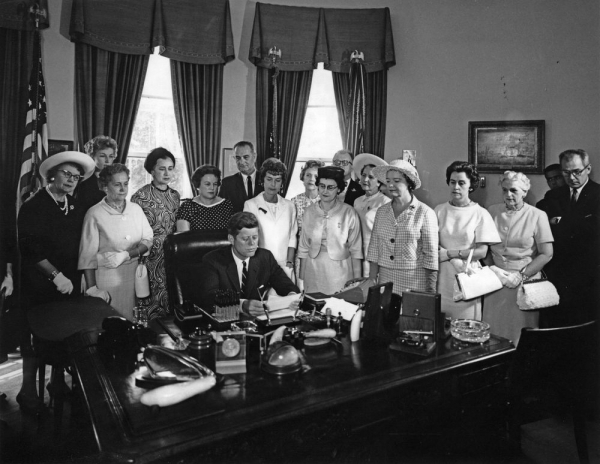SAXTONS RIVER — Poor Lilly Ledbetter must be tearing her hair out. She is the woman, you may recall, who, she once said, “sought justice because equal pay for equal work is an American value.”
Her legal fight took place some years ago when she learned that she was earning significantly less money than men doing the same managerial work in the Alabama tire plant where she worked for nearly 20 years.
The case ultimately went to the Supreme Court in 2007, where in a 5–4 decision, the court “stood on the side of those who shortchanged my pay, my overtime and my retirement just because I [was] a woman,” she lamented.
The Court had ruled that she didn't report the inequity within the required 180 days, even though she didn't discover the discrepancy for nearly two decades.
“In the end,” she said, “I didn't get a dime of the money I was shortchanged.”
* * *
What she did get, ultimately, was the Lilly Ledbetter Fair Pay Act of 2009, signed into law by President Barack Obama.
The law allowed individuals who faced pay discrimination to seek rectification under federal anti-discrimination laws. It also clarified that wage discrimination based on age, religion, national origin, race, sex, and disability would “accrue” every time an employee received a paycheck deemed to be discriminatory.
It was the first bill Obama signed, and it became one of several federal laws designed to protect workers' rights.
Prior to that, in 1963, the Equal Pay Act, signed by President John F. Kennedy, made it illegal for employers to pay women less for performing the same jobs as their male counterparts. However, it had several loopholes that needed to be addressed. Then, Title VII of the Civil Rights Act of 1964 prohibited employment discrimination on the basis of sex.
The Ledbetter act added to those prior acts by reversing the short statute of limitations for wage discrimination.
That's all well and good, but why are women still earning 82 cents on the dollar (if they're white) compared to men? And what are the ramifications?
* * *
The first thing to understand is that the gender pay gap exists in every occupational category, even when accounting for educational levels, skills, and worker's choices.
Assumptions like the ones men and managers often make are a big part of the problem.
For example, one assumption is that women choose lower-level or lower-paying work because they are mothers who bear the brunt of responsibility in meeting children's needs. But as the Covid crisis revealed, the lack of child care in this country leaves women little choice.
Such assumptions ignore the underlying causes of workplace discrimination and often lead to women being pushed out of their chosen career fields. Some of those underlying causes, in addition to not having affordable child care, are the lack of adequate parental leave policies, flexible working conditions, and paid family and medical leave, which most industrialized nations offer.
Importantly, advocates for equal pay underscore the fact that pay discrimination occurs in almost every field of work. Women, who are overrepresented in the lowest-paid industries, take the hardest hit. Collectively, women lose hundreds of thousands of dollars annually because of the pay gap driven by gender and race.
That loss has real-time, long-term consequences.
Underpaid workers, primarily women, suffer lowered Social Security benefits, retirement pensions, and personal savings, which is why so many female elders find it difficult to survive with dignity in their later years.
* * *
To address these inequities, in 2014, the Paycheck Fairness Act was first introduced in the Senate by Sen. Barbara Mikulski (D-Md.), essentially as an amendment to the Fair Labor Standards Act of 1938, but it failed to be adopted.
In January this year, Rep. Rosa DeLauro (D-Conn.) introduced the Paycheck Fairness Act of 2021. It has passed in the House in April.
This bill addresses wage discrimination on the basis of sex, which includes pregnancy, sexual orientation, gender identity, and sex characteristics.
As currently proposed, a requirement of the Paycheck Fairness Act is that employers would have to provide detailed information to the federal government, which would ensure that the Equal Employment Opportunity Commission (EEOC) and the Department of Labor have the necessary tools to enforce laws against pay discrimination, including employment-related data from employers analyzed by race, gender, and employees' national origins.
The act, if enacted, would also prevent retaliation against workers for discussing salary with colleagues, and it would prohibit employers from asking about a person's salary history. In addition, it would allow workers to participate in class-action lawsuits that challenge systemic pay discrimination.
* * *
The Biden administration has a committed focus on pay equity, a particular interest of Vice President Kamala Harris.
Major corporations will soon be dealing with multi-million-dollar settlements in class-action equal-pay claims, and employers are likely to face big changes and a lot of scrutiny with regard to pay equity - not just around gender, but also around race.
In addition to federal efforts, states are beginning to step up their equal pay laws, too.
All that bodes well, but as we know, things move at a snail's pace when it comes to enacting and enforcing legislation.
Until there is true equality in wages and salaries, women are among many people who continue to wait for fairness in the workplace.
For them, 82 cents on the dollar remains inadequate - and clearly insulting.
